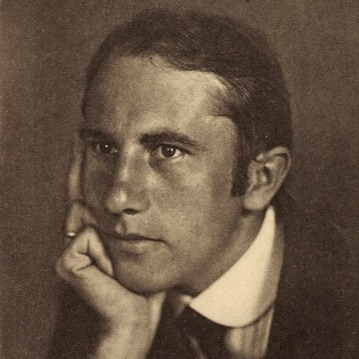
Heinrich Campendonk
Heinrich Campendonk, a German-Dutch painter, stained glass artist, and printmaker.
Biography of Heinrich Campendonk
Heinrich Campendonk was born in 1889 in Krefeld, the son of Heinrich Gottfried Campendonk and his wife Catharina. His father operated a small agency and commission business under challenging financial circumstances. In 1904, at the age of fifteen, Campendonk enrolled at Krefeld's Fachschule für Textilkunde. A year later, he abandoned a course that, given the local textiles industry, would have provided ample opportunities for earning a living. Instead, he chose a place at the Handwerker- und Kunstgewerbeschule.
Despite going against his father's wishes, Campendonk could only pursue his studies until the summer of 1908. During this time, he befriended fellow students Walter Giskes, Will Wieger, and particularly Helmuth Macke, cousin of the painter August Macke. In 1908 and 1909, he temporarily shared a studio near Krefeld with them. Financial difficulties led him to contribute to the Osnabrück cathedral murals in 1910.
After studying under the Dutch artist Johan Thorn Prikker at the Krefeld 'Kunstgewerbeschule,' Campendonk accepted Franz Marc's invitation to the Bavarian village of Sindelsdorf and relocated there in 1911. At that time, Campendonk had already chosen the fundamental theme of his works: the portrayal of harmony between humans and animals, Creation, and the endless cycle of life and death. He created paintings, watercolors, gouaches, and his initial woodcuts.
Connections were established with the Neue Künstlervereinigung München and the breakaway group Der Blaue Reiter, formed by Marc and Kandinsky. Campendonk encountered Jean Bloé Niestlé, Alexej von Jawlensky, Gabriele Münter, and Paul Klee. He participated in the first exhibition of Der Blaue Reiter at Galerie Thannhäuser in Munich and was featured in the 1912 almanac bearing the group's name. In the spring of 1912, he married his girlfriend, Adda Deichmann.
While the artist's entry to the Cologne Sonderbund exhibition that year was rejected, he did participate in the Ausstellung Rheinischer Expressionisten in Bonn in 1913—thanks to August Macke's intervention—and in the Erster Deutscher Herbstsalon at Herwarth Walden's avant-garde gallery Der Sturm in Berlin. The outbreak of the First World War in 1914 led to the loss of his friend August Macke in September, followed two years later by the death of Franz Marc. From 1915 onward, Campendonk was repeatedly called up for national service but only conscripted for short periods and, due to health reasons, was never sent to the front.
After being released from military service in 1916, the artist relocated to Seeshaupt on Lake Starnberg. His affiliation with Berlin's revolutionary Novembergruppe was a non-political move, contextualized by the collective decision of all Der Sturm artists to be associated with it. Following the conclusion of the war, Campendonk gradually distanced himself from Herwarth Walden, who had been his exclusive agent until then. In 1921, a dispute solidified the separation. The artist returned to his hometown of Krefeld, where he resided from 1922 to 1932. From 1923 to 1924, he worked as a set designer for the local theatre. During the same period, he held a one-year teaching position at the Kunstgewerbeschule of Essen, where he taught "Surface Art."
Then, in 1926, he was appointed to the Düsseldorf Kunstakademie as Thorn Prikker's successor. In the ensuing years, he received numerous commissions to create glass windows for secular and religious purposes. In 1932, his marriage to Adda ended, leading to a second marriage to the Flemish artist Edith van Leckwyck in 1935.
In response to the Nazi defamation, Campendonk chose to emigrate. He spent 1933 on the Lofoten Islands, where he was granted sabbatical leave but was dismissed from his teaching duties one year later. Following a significant dispute in the press, he was appointed to a chair at the Rijksacademie van beeldende Kunsten in Amsterdam in 1935. With the German invasion of the Netherlands in 1940, he faced increasing threats and narrowly avoided a Gestapo raid by hiding for hours with his wife inside a piece of furniture. These experiences had a lasting impact on Campendonk.
After the war, the artist resumed teaching activities in Amsterdam. His growing reputation in Germany led to numerous commissions for glass windows in secular public buildings and churches. Campendonk's work as a stained glass artist continued to earn him considerable acclaim, including winning a Grand Prix at the Exposition Universelle in Paris in 1937.
A year after being knighted in the "De Nederlandse Leeuw" order, Heinrich Campendonk passed away in 1957 in Amsterdam.
Heinrich Campendonk's Art Style
Heinrich Campendonk held a deep admiration for primitive art and folklore, with animals frequently taking center stage in his creations. His paintings, often imbued with a mystical tone, portrayed animals in natural settings and were influenced by Franz Marc's approach. Unlike Marc, Campendonk frequently incorporated figures into his compositions.
After the conclusion of the First World War and the passing of Marc and August Macke, Campendonk underwent a stylistic transformation. He chose to destroy much of his earlier work and adopted a painting style influenced by the dreamlike imagery of Marc Chagall, whom he had met in 1914. In the early 1920s, he ventured into stained glass design, and this public art form became a significant focus of his later career.
Years:
Born in 1889
Country:
Germany, Krefeld, North Rhine-Westphalia
Gallery: